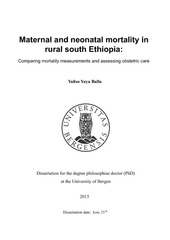| dc.description.abstract | Introduction: The aim of the Millennium Development Goals (MDG 4 and 5) is to substantially reduce maternal and child mortality in the world. However, information is limited in low-income countries to help oversee progress towards the MDG targets. In developed countries, quality data are obtained through routine vital registrations. Unfortunately, registry-based data are lacking or incomplete in most developing countries, and Ethiopia is no exception. As such, we had a scarcity of information on the level of maternal and neonatal mortality, as well as the coverage and quality of obstetric services in south Ethiopia. The information is important because the target for MDGs in 2015 and the preparation for the Sustainable Development Goals (SDGs) are fast approaching. Objective: The aim of the thesis was to measure and compare maternal and neonatal mortality and obstetric services through community- and facility-based methods in southern Ethiopia. Methods: We used four different methods to measure maternal mortality, and in one of these methods assessed one-year obstetric services in all health centres and hospitals in Gamo Gofa (population 1.8 million in 2010) in south Ethiopia. The methods were: 1) Between January and December 2010 health extension workers prospectively registered births and birth outcomes in 75 rural villages in three districts in south Ethiopia (population of 421,639 people) (Paper I); 2) In February 2011, we conducted a survey in 6,572 households that reported pregnancy and birth outcomes in the previous five years (2006-2010) out of a total of 11,920 households in 15 out of 30 randomly selected rural villages in the district of Bonke (Paper II); 3) Using the sisterhood method, we estimated the lifetime risk of pregnancyrelated deaths and MMR through interviewing 8,503 adult siblings from the 15 kebeles where the survey for Paper II was conducted in Bonke (Paper III); and 4) We reviewed one-year institutional records on births, birth outcomes (maternal deaths), and signal functions of emergency obstetric care in all 63 health centres and three hospitals in Gamo Gofa. We then calculated the population coverage of obstetric care, the rate of skilled birth attendance, and the quality of obstetric service against the UN’s minimum standards (Paper IV). Results: In 2010, we recorded 10,987 births and 53 maternal deaths (an MMR of 489 per 100,000 LBs, with 83% (44/53) of maternal deaths occurring at home. The MMR was associated with the education level of the father of the baby, access to driveable roads, and sickness of the mother during pregnancy (Paper I). In the household survey (Paper II), we enumerated 11,762 births and 49 maternal deaths (an MMR of 425 per 100,000 LBs), and of the maternal deaths, 87% (43/49) occurred at home. The poorest households and those with illiterate household heads had a higher MMR. We also found 308 neonatal deaths (an NMR of 27 per 1,000 LBs). Neonatal mortality was associated with household wealth, a residence far from a driveable road (≥ 6 km), and narrowly spaced births in the households. We estimated a lifetime risk (LTR) of 1 in 10 pregnancy-related deaths with a corresponding MMR of 1,667 per 100,000 LBs by interviewing 8,053 siblings (brothers and sisters). Because of the indirect nature of the method, the estimate refers to the year 1998 (12 years before the survey). In the facility review (Paper IV), we recorded 4,231 pregnancy- and birth-related admissions (6.6% of an estimated 64,413 births in the area in the same year), and found 79 maternal deaths in the institutions. This resulted in a quarter of the MMR being measured through the birth registry (120 vs.489 per 100,000 LBs). Out of the studied 66 health institutions, only three met the basic-, and two satisfied the comprehensive emergency obstetric care standards. The coverage and quality of emergency obstetric care (EmOC) was below the UN’s recommended minimum of five basic and one comprehensive EmOC facility for every 500,000 people. The rate of institutional delivery was very low (on average, 3.7% between 2006 and 2010, and 6% in 2010) in rural villages. Three studies consistently showed that more than two-thirds of maternal deaths occurred at home (Papers I, II, IV). Conclusion: Community-based measurement methods (birth registry and household survey) provided comparable results of the MMR, which was high with most of the deaths occurring at home. The proportion of skilled birth attendance and EmOC was low. It is possible to conduct birth registries in rural communities where functional system of community health workforce is available and use it as a tool to measure birth outcomes. | en_US |
